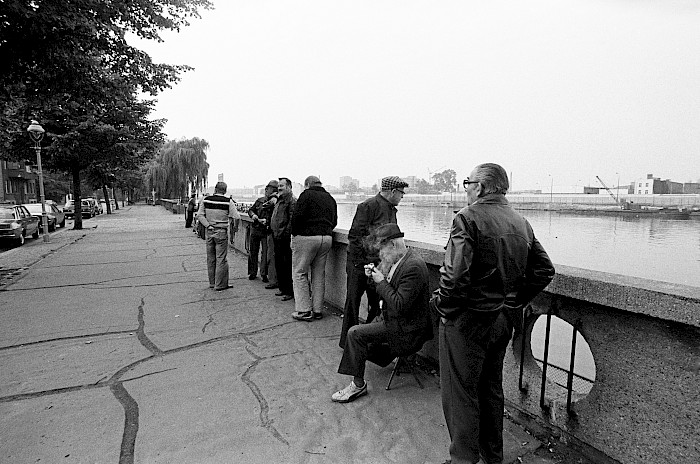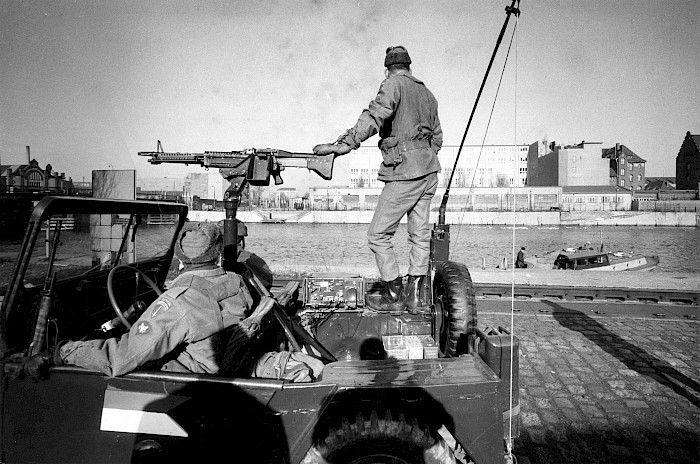1961
– 1989

In the Kreuzberg district of West Berlin, the view of the Wall and the river that marked the border was part of everyday life. The river was a popular leisure spot, though swimming was prohibited. The Spree here belonged to East Berlin and anyone who got into difficulties in the water, or helped someone else in the water, was in danger of being shot at by GDR border soldiers. For this reason, at least six people from West Berlin died in the Spree – apart from refugees from East Berlin. The soldiers did not always take the same action: Sometimes they rescued people in the river and sent them back to West Berlin.
"I went with grandmato feed the ducks and look at the Vopo boats."


Udo Düllick was the first person to die trying to escape across the Spree — in October 1961 near Oberbaumbrücke. Shot at by GDR border guards, he became so weakened that he drowned. At least seven men died in this section of the Spree while trying to escape from the GDR: In 1961, Werner Probst was shot by border soldiers; in 1962, Anton Walzer, as was Manfred Weylandt in 1972. In 1965, an unknown fugitive died near the former Brommy Bridge. Philipp Held and Hans-Joachim Zock, who entered the water at an unknown point, also died trying to swim across the river here. To the east of Oberbaumbrücke, near Osthafen, and to the west, below Schillingbrücke, two more people died during attempts to escape across the Spree.

"Children drowned close to the riverbank…"
While the bank of the Spree in West Berlin was a popular leisure spot, it was also a danger zone. Four children died at the border here between 1972 und 1975. Cengaver Katrancı (aged 8), Siegfried Kroboth (aged 5), Giuseppe Savoca (aged 6) und Çetin Mert (aged 5) fell into the water and drowned. The GDR border guards reacted too late and none of the onlookers in West Berlin dared go into the water to rescue them. To prevent further accidents, the West Berlin Senate installed fences and an emergency call box in 1976. Another boy, Andreas Senk (aged 6), had drowned in 1966. Nobody had noticed he had fallen into the river until it was too late.
In the painting Mauerdurchbruch ( Wall Breakthrough) by Sándor Györffy, abstract geometric shapes fly out of two heads towards each other. To the artist, the heads symbolised East and West Berlin. The bar stands for the Berlin Wall, broken through by the force of language.
Udo Düllick drowned in the Spree near the Oberbaum Bridge on 5 October 1961. He had come under fire while trying to escape.
https://www.chronik-der-mauer.de/todesopfer/171446/duellick-udo
Werner Probst was shot and killed on 14 October 1961 while trying to escape across the Spree at the sector border between Berlin-Friedrichshain and Berlin-Kreuzberg.
https://www.chronik-der-mauer.de/todesopfer/171440/probst-werner
The body of Philipp Held was retrieved from the Spree by GDR border police on 22 April 1962. All signs suggest that he drowned while trying to swim from the Osthafen grounds in Berlin-Friedrichshain to the opposite bank in West Berlin.
https://www.chronik-der-mauer.de/todesopfer/171415/held-philipp
Anton Walzer died on 8 October 1962 after being shot in the back of his head while he was trying to escape across the Spree near the Oberbaum Bridge.
https://www.chronik-der-mauer.de/todesopfer/171431/walzer-anton
Ulrich Krzemien swam from the West Berlin side of the river in Kreuzberg to East Berlin on 25 March 1965. He presumably died from exhaustion.
https://www.chronik-der-mauer.de/todesopfer/171394/krzemien-ulrich
A man, approximately 30 years old, drowned in the Spree during an escape when his strength failed him just shortly before he reached the other side of the river. His identity remains unknown.
https://www.chronik-der-mauer.de/todesopfer/171393/unbekannter-fluechtling
Hans-Joachim Zock drowned while trying to flee across the Spree River from Berlin-Friedrichshain to Berlin-Kreuzberg between 14 and 17 November 1970.
https://www.chronik-der-mauer.de/todesopfer/171360/zock-hans-joachim
The West Berliner Heinz Müller was shot and killed by GDR border soldiers near the Schilling Bridge on the sector border between Berlin-Kreuzberg and Berlin-Friedrichshain.
https://www.chronik-der-mauer.de/todesopfer/171357/mueller-heinz
Manfred Weylandt was shot and killed on 14 February 1972 while trying to escape across the Spree at the sector border between Berlin-Friedrichshain and Berlin-Kreuzberg.
https://www.chronik-der-mauer.de/todesopfer/171346/weylandt-manfred
On the morning of 13 September 1966, Andreas Senk (age 6) was pushed into the Spree River by a playmate and drowned.
https://www.chronik-der-mauer.de/todesopfer/171382/senk-andreas
Cengaver Katranci (age 8) drowned in the Spree River on 30 October 1972, when he lost his balance and fell into the water while playing with friends at Gröbenufer in Kreuzberg.
https://www.chronik-der-mauer.de/todesopfer/171345/katranci-cengaver
On the morning of 14 May 1973, Siegfried Kroboth (age 5) was playing with a friend on the Kreuzberg riverbank near the war-damaged Brommy Bridge, when he fell into the water and drowned.
https://www.chronik-der-mauer.de/todesopfer/171342/kroboth-siegfried
On 15 June 1974, Guiseppe Savoca (age 6) drowned while playing with a friend on Gröbenufer in Berlin-Kreuzberg. He had been fishing with a stick in the water when he lost his balance and fell into the river.
https://www.chronik-der-mauer.de/todesopfer/171339/savoca-giuseppe
Cetin Mert (age 5) drowned in the Spree River while playing on Gröbenufer on 11 May 1975. He was trying to get his ball out of the water when he fell into the river.
https://www.chronik-der-mauer.de/todesopfer/171336/mert-cetin
Additional information:
Die Podcast-Reihe „Grenzerfahrung“ von der Stiftung Berliner Mauer entstand 2021 anlässlich des 60. Jahrestags des Mauerbaus und wurde gefördert von der Bundesbeauftragten für Kultur und Medien. In der Folge „Alltag in Teilung“ wird darüber gesprochen, wie sich das Leben im geteilten Berlin entwickelt hat. Die hohe Betonmauer gehörte zum Alltag der Bewohnerinnen und Bewohner Berlins. Aber nicht alle Menschen wollten die Grenzabriegelung hinnehmen, sie versuchten, aus der DDR zu fliehen. Expertinnen und Experten geben Auskunft über das Grenzregime der DDR und berichten von den mindestens 101 Menschen, die bei einem Fluchtversuch ums Leben kamen oder inhaftiert wurden. https://www.stiftung-berliner-mauer.de/de/stiftung/podcast-grenzerfahrung